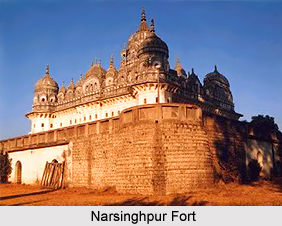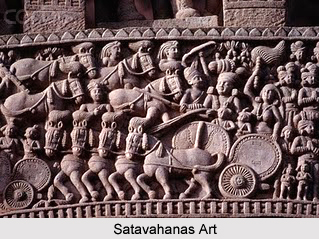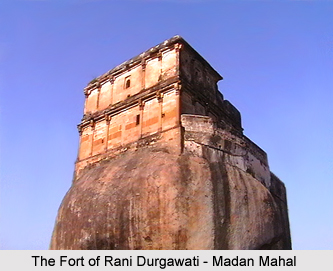 History of Narsinghpur district states that the area of the district was inhabited by ancient people. This was evident from the discovery of several fossils and stone tools. The district is situated in the central parts of Madhya Pradesh. It attracts special attention because of its natural situation and historical importance. In the ancient period, this area was ruled by many Rajvansh including great historical worrier Rani Durgawati which was referred by various names in that period. In the 18th Century Jat Sardars constructed a large Temple, in which Idol of Lord Narsimha was placed.
History of Narsinghpur district states that the area of the district was inhabited by ancient people. This was evident from the discovery of several fossils and stone tools. The district is situated in the central parts of Madhya Pradesh. It attracts special attention because of its natural situation and historical importance. In the ancient period, this area was ruled by many Rajvansh including great historical worrier Rani Durgawati which was referred by various names in that period. In the 18th Century Jat Sardars constructed a large Temple, in which Idol of Lord Narsimha was placed.
The village Gadariya Kheda became "Narsinghpur" and afterwards, it become the headquarters of Narsinghpur district
Bilthari gram of block Chanwarpatha was previously known as Balisthali. This place was known as King Bali`s place. It is said that the Pandavas had spend some period of their exile at this place, which is confirmed by places like Bhim Kund and Arjun Kund. A cave near Sankalghat was also associated with Adi Shankracharya`s place of studies and meditation.
 Village Barhata of Narsinghpur district is a remnant of Virat Nagar of Mahabharata period. Several ancients structures and architectural remains found in this village leads to the conclusion that this area formed a part of Mahabharata period. An ancient rock with the shape of human being is related with `Keechak` near village Bachai. The area of Bohani is related with Jasraj, father of Aalaha Udal and uncle Bachraj, who were kings during the period of King Prithviraj Chauhan. During several historical excavations, various ancient monuments and reference also found which relates this area with ancient periods.
Village Barhata of Narsinghpur district is a remnant of Virat Nagar of Mahabharata period. Several ancients structures and architectural remains found in this village leads to the conclusion that this area formed a part of Mahabharata period. An ancient rock with the shape of human being is related with `Keechak` near village Bachai. The area of Bohani is related with Jasraj, father of Aalaha Udal and uncle Bachraj, who were kings during the period of King Prithviraj Chauhan. During several historical excavations, various ancient monuments and reference also found which relates this area with ancient periods.
Satavahans in Narsinghpur District
During the 2nd Century, this area was under the rule of Satvahans. From 4th century the area was under the Gupta Kingdom, during which King Samudra Gupta succeeded in extending the areas of his Kingdom in Central India and Western parts of India in the 6th Century had certain indications of the Padi Kingdom. But once again history lost in vein for around 300 years. In 9th century Kalchuri Kingdom established here. The Capital of Kalchuri Rajvansh was Mahishmati Nagari near Narmada River which later established at Tripuri. The Kalchuri Kingdom was expended between Gomati River and Narmada and after the fall of Kalchuri, the area was under the control of father and uncle of Aalh Udal who made Bohani as their centre. During 4th century, this area was part of the Raj Gond Vansh Empire.
Raj Gond Vansh Empire in Narsinghpur District
After the establishment of the Raj Gond Vansh an area of piece & prosperity began in Narsinghpur. This Vansh came to existence by Yadav Rao who laid the foundation of a strong kingdom at a place called Garha-Katanga and started a process of strong and mighty rule. One of the rulers, Sangram Shah (1400-1541) had established 52 Garh, and thus strengthened the Gond Tribe Empire. The fort of Choura Garh (Chougan) at Narsinghpur was constructed by Sangram Shah, which is still an evidence of bravery of Veerarayan, the son of Queen Rani Durgawati. Among the followers of Sangram Shah, Dalpati Shah ruled for a period of 7 years peacefully. After that, Queen Durgawati took the reign and gave a proof of courage and bravery and ruled for a period of 16 years. In the year 1564 the queen died while fighting bravely, giving tough fight to Asif Khan the Sepoy Salar of Emperor Akbar.
In Narsinghpur district at the Fort of Chauragarh, Asif Khan trapped prince Veer Narayan and killed him by his cunning tactics. Thus Garha Katanga went under the control of the Mughal dynasty in the year 1564. Gonds, Mughals and after them the area was under the control of various officers and administrative and hereditary chiefs during the Maratha rule. So, the boundaries of this area continued to change according to the powers and influence of their people. Chawarpatha, Tendukheda, Saikheda, Barha, Singhpur, Gadarwara, Shahpur and Shrinagar were headquarters of various parganas.
Bhonsle Rule in Narsinghpur District
 In the year 1785, Madhavji Bhonsle purchased the area of Mandla and Narmada ghati in 27 lakhs and the area was under pressure of army rule during the reign of Radhoji Bhonsle, Nawab of Bhopal and Pindaris. Due to unsuitability and other problems, the common people were extremely exploited. This period was also known as the period of problems and unsuitability. At last, in the year 1817, British rule came into existence.
In the year 1785, Madhavji Bhonsle purchased the area of Mandla and Narmada ghati in 27 lakhs and the area was under pressure of army rule during the reign of Radhoji Bhonsle, Nawab of Bhopal and Pindaris. Due to unsuitability and other problems, the common people were extremely exploited. This period was also known as the period of problems and unsuitability. At last, in the year 1817, British rule came into existence.
British Rule in Narsinghpur District
After the Batttle of Sitabardi, Narsinghpur came under the control of the British in the year 1917, which was confirmed by an alliance in the year 1926. In this period, the area was known as Gadarwara pargana. The Gond Jagirs were under Maratha Empire where as Sindhiyas had given Barha and Paloha Jagirs to Pindari Sardars, Chitu and Karim Khan. In the year 1818, army of the British East India Company captured the Fort of Chouragarh and in 1830, the control of this area was given to a committee. During British rule the administration of this district was further improved and in the year 1836 the area was partitioned and was merged in Hoshangabad district. However, after the Bundela revolt in the year 1843, this part was once again reinstated in this district.
Despite strong British rule the desire for independence was prevalent among the common people. In 1825 Chawarpatha and Tendukheda were given to British Government. In the year 1857, the Police station of Chawarpatha and Tendukheda were captured by revolutionaries under the leadership of Gond Chief Delanshah of Nadanpur and with this the struggle for independence was started in the Narsinghpur district. But in the year 1858, Delanshah caught and hanged to death.
Congress Movement in Narsinghpur District
After the establishment of Indian National Congress in the year 1885, even in Narsinghpur district the feeling for Independence was prevalant and strong efforts were made by the people here. Being motivated by the efforts and leadership of Lokmanya Tilak, Pandit Jawaharlal Nehru, Subash Chandra Bose and Mahatma Gandhi, the leaders of his district including Manik Chand Kochar, Gayadutt, Choudhary Shankar Lal, Sri Shyam Sunder Narayan Musharan and Thakur Niranjan Singh lead the people of this district towards the Independence movements. In order to break the unity and enthusiasm of the people, the British had once again partitioned the district and merged it with Hoshangabad district but even then, enthusiasm as well as fight for independence continued in the people`s mind. During the mass demonstration of satyagrah at Chichli in the year 1932, Mansharam and Gauradevi lost their lives during police firing.
A large number of revolutionaries faced the atrocities of the British rule and gave an example of strong devotion for the country and snipe against the British rule. When India attained Independence on the 15th of August 1947, a new era started in this district. After nine years of Independence when states were reorganized on the basis of languages, Narsinghpur once again became a district on 1st November 1956.






